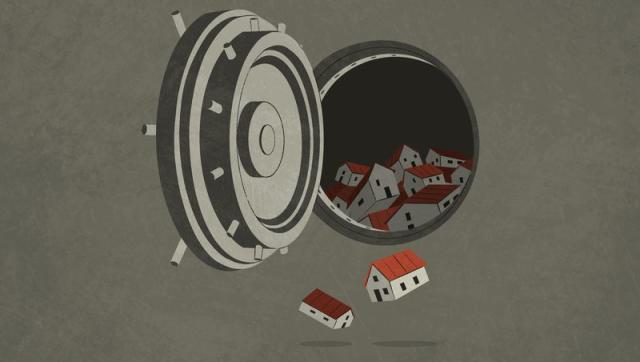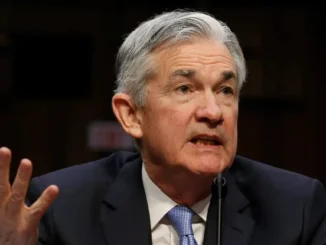
A few years ago, as my wife and I awaited the arrival of our second child, we — like many who came before us — started to feel cramped in our two-bedroom home. We loved the tree-lined streets of our neighborhood, though, so we started combing Zillow for nearby houses. Over the the next few months we looked at pretty much every listing within a five-mile radius. We went to every open house. We talked to more real estate agents than I can count.
Eventually a bigger house on our street went up for sale, and the rest is history.
I probably would have gradually forgotten the details of our home search, except that a year or so later I was scrolling Airbnb trying to find a place for some visiting family to stay. Suddenly, I saw the big American foursquare I had toured, now listed as a short-term rental. Not far below, I saw the bungalow with the landscaped yard. And there was the flipped Victorian.
In fact, the more I scrolled through Airbnb listings, the more houses I found that had once been on my short list of places to move. Pretty soon, it seemed like every house that had gone up for sale over the prior year had turned up as a short-term rental.
I have no idea how the market can support so many short-term rentals in what look like haunted old houses in quiet Salt Lake neighborhoods.
But the experience highlighted the huge changes that have lately rattled the housing industry. A generation ago, my parents might have competed during their home searches with other would-be residents. That still happens today, but now the competition also includes people effectively running hotels in residential neighborhoods, Wall Street landlords and institutional mega-flippers with venture capital.
Almost none of these players existed a decade and a half ago. And they’ve risen at the same time that home prices have climbed to record highs. It’s a brutally competitive housing market out there, and so it makes sense that these new kinds of real estate investors have sparked a sense of wariness that housing is moving out of reach for many Americans.
The good news is that even with all the disruption of recent years, the homeownership rate in the U.S. remains remarkably stable.
But the trend clearly shows competition increasing, and if we want people in the future to have the same opportunities — or better ones — to find housing as people did in the past, we’re going to need to be proactive. As much as I tend to favor free markets, the intensity of the changes in the housing market of late means this isn’t just something we can leave to chance. We’ll probably need a few more rules.
What’s at stake here is obviously the material well-being of people who need housing, which is to say everyone.
But there’s also something deeper. The U.S. has long been, and explicitly thinks of itself as, a nation of homeowners. The fact that most Americans could own their own homes was unique, at least compared to the creaky old feudal world, and it was essential to the idea of a democratic society. The people ruled themselves politically in part because they ruled their own property.
We were never perfect at actually achieving that idea, and plenty of folks were left out. And over the past two centuries we’ve perhaps become less unique as the rest of the world caught up. But this idea of a nation of landowners is baked into the idea of America. And that means if housing does gradually slip beyond the grasp of everyday Americans, we risk losing not just the roofs over our heads but also the sense of who we are as a people.
Are corporate investors really gobbling up all the housing?
Historically, investment in housing took place on a hyperlocal level. Someone might buy the empty lot next to their own home and build a second house or small apartment building as a supplemental source of income. Of course some developers were bigger than others, but that scale of development in the past is why older neighborhoods like Salt Lake City’s Avenues have such varied housing stocks; different developers with different visions built those kinds of places over time, parcel by parcel. This in turn created a patchwork of owner occupants and mostly local investor-owners. And that was true even as late as the 1960s and 1970s, when places like Los Angeles saw an explosion of development that included thousands of locally owned investment properties known as dingbats.
A slew of new building and financing regulations started changing the housing landscape in the final decades of the 20th century. Gradually, bigger institutions started investing more heavily in housing, first focusing mostly on multifamily buildings.
However, after the Great Recession drove down home prices and created an abundance of foreclosures, major corporations formed and aggressively snapped up single-family houses as well.
This proved to be a paradigm-shifting moment. Suddenly, buying single-family investment properties wasn’t just something for mom-and-pop who wanted the house next door. Now, it was for Wall Street. Companies that took off in this period include AMH, formerly American Homes 4 Rent, which was founded in 2012 and today touts a catalog of more than 60,000 homes occupied by nearly 200,000 tenants. Invitation Homes, also founded in 2012, notes on its website that it has “80,000 homes and counting.”
Both companies are traded on the New York Stock Exchange.
Other major players in the single-family rental sector include Tricon Residential and Progress Residential. Collectively, these companies own hundreds of thousands of single-family homes across the U.S.
A few years after the rise of the big institutional landlords, another well-funded group got into the game: the so-called “instant buyers,” which was ultimately shortened to “iBuyers.” These companies are effectively tech-enabled home flippers; using advanced pricing algorithms, they make cash offers on homes, rehab those homes, and then turn around and sell them. The biggest player in the space is Opendoor, which was founded in 2014 and initially funded in part by Softbank, a famous Japanese mega venture fund that has also backed companies such as WeWork and DoorDash.
Opendoor went public in 2020, and last year flipped just under 40,000 homes — though it also lost $1.4 billion and is facing questions about its viability in a slower housing market.
And then there’s the type of investors I noticed while searching my neighborhood: Airbnb. Though individual short-term rental operators are often local, this new use case for housing is similar to iBuying in the sense that it was enabled by advancements in technology. It also relies on venture capital and Wall Street-propelled platforms such as Airbnb and Vrbo.
To get a sense of how big this sector is, I reached out to AirDNA, an analytics company that tracks short-term rentals. They told me that as of January, the Salt Lake City area had 4,563 short-term rentals available, which is a jump of 28% compared to a year earlier. Demand for short-term rentals in the Salt Lake area has been generally rising since the beginning of the pandemic and as of the beginning of the year was higher than at any point since 2019. Moreover, AirDNA said that “2022 was a record year for short-term rental demand in Salt Lake City, with over 600,000 nights stayed.”
The chart below is based on AirDNA data and shows the total number of short-term rentals in Salt Lake going all the way back to 2018. And while there have been ups and downs, particularly during the pandemic, the overall trend is indeed upward.
Similar trends have taken place in other cities as well. According to AirDNA, Boise had 2,513 available short-term rentals in January, up 37% compared to a year earlier.
Meanwhile, Phoenix is “having a huge [short-term rental] boom” right now, AirDNA told me, with the region “seeing the highest growth in demand of all top 50 metros in the U.S.” during the first month of 2023. In total, the metro area had 15,936 short-term rentals in January, up 22% year-over-year — though in Phoenix’s case the Super Bowl recently helped boost the area’s numbers.
That’s a lot of numbers, but the point is that recent years have seen an explosion of interest in short-term rentals. And the Airbnb explosion has also coincided with the rise of other disruptors such as iBuyers and institutional landlords.
Obviously there are some upsides. I know people who rely on the income from renting parts of their homes on Airbnb. I’ve stayed in short-term rentals myself, and while I’ve found many of those experiences to be lackluster, occasionally they’ve been amazing — the time I stayed on a boat in the Florida Keys comes to mind.
Aside from short-term rentals, institutional landlords have also in some cases been found to offer faster service for their tenants compared to more traditional mom-and-pop operators. And the iBuyers have consistently made the case that they’re providing certainty and speed to homeowners who don’t want to go through the hassle of a conventional real estate listing. What I’m trying to say, then, is that this is not a screed against these new disruptors.
But there are downsides too.
For instance the National Association of Realtors (NAR) found that institutional buyers accounted for 15% of residential home purchases in 2021 — and that they grew their share of the market in most of the U.S. that year. And while those institutional buyers were providing rental housing, NAR also points out that this activity “takes stock away from future homeowners.”
In a similar vein, Pew found that a flurry of investor activity in 2021 drove up rents for families in the suburbs. The U.S. Department of Housing and Urban Development has similarly argued that institutional investors often drive up home prices, potentially displacing existing residents.
Both NAR and Pew pointed to states such as Texas and Georgia as among the most popular for investors. On NAR’s list, institutional investors in 2021 bought up 16% of the residential market in Utah — where I live — putting the state in 10th place.
Another potential downside, on top of driving up costs and competition, is that when one player gets a lot of market share, it ends up with a lot of power too. Case in point: Last fall, a new report accused major landlords of using algorithm-based software from technology firm RealPage to send rents skyrocketing, leave some units vacant and upend the practice of negotiating a lease.
Elsewhere, institutional landlords have been known to draw on vast cash reserves to outbid individual homebuyers. And of course the rise of Wall Street landlords upends traditional wealth circulation; historically, many of the investors who built California’s dingbats or the historic neighborhoods in cities like Salt Lake also resided in those communities, meaning the money made on housing circulated locally. Major corporations that own homes — or, increasingly, build dedicated single-family rental neighborhoods — are effectively machines for exporting wealth from one community to another.
The end result is an ever more competitive housing environment in which renters and would-be homeowners practically have to gird themselves for war just to find a place to live.
What else is ailing the housing landscape?
There’s a lot to be frustrated about regarding the way the housing landscape has evolved in the past few years. But a little context is in order too, because big money isn’t the only thing creating big issues.
To get that context, I reached out to Rick Palacios, Jr., director of research and managing principal for John Burns Real Estate Consulting. And he provided me with the chart below, which shows the breakdown in market share for different types of housing investors in Salt Lake City.
Clearly, iBuyers and large investors have grown their market share in recent years. And small mom-and-pops — or investors with between one and nine properties — have lost share.
But the data also show that big institutions are still a small minority of the overall investing landscape. And the total share of the market going to investors isn’t much higher than it was a decade ago. Things haven’t actually changed that much.
The graph also shows the same data for Phoenix.
Investors have clearly upped their share of the Phoenix market, and the data reflect the city’s role as an epicenter of activity for new concepts such as iBuying. But even then, the institutions are still minority players.
That doesn’t mean the housing market isn’t brutal right now. It is. Home prices during the pandemic soared to record highs, and in the course of reporting on the industry I routinely talk to real estate agents who have been through so many bidding wars they sound like grizzled combat veterans. Home prices have just started to come down, but mortgage rates have now risen to their highest point in decades — meaning that, even with lower prices, homes are no more affordable.
But it is worth keeping in mind that the radical changes and well-financed disruption are still relatively limited forces in real estate.
What can we do to make housing more accessible?
Luckily, there’s no lack of solutions to deal with the many factors contributing to the housing crunch.
One of the most popular ways for cities to tackle the above-mentioned problems is by cracking down on short-term rentals. Several years ago, for example, Los Angeles limited Airbnb-style listings to hosts’ primary residences and imposed a cap on how long those properties can be rented out. Numerous other cities have followed suit, often explicitly with the goal of making homes available to longer-term residents.
In my city, Salt Lake, Airbnbs technically fall into the same category as hotels because the lease durations are so short, and they are thus also technically illegal in residential zones.
Tackling Airbnbs is relatively low-hanging fruit. Even lower hanging fruit is enforcing the laws that are already on the books; aside from places like Salt Lake, where short-term rentals are abundant but technically disallowed, a recent report out of Los Angeles suggested that megapolis’ pioneering rules are basically going unenforced, allowing thousands of housing units to leave the market.
Reining in other institutional investment in housing is a harder nut to crack, though some lawmakers are trying. Last fall, a group of Democrats introduced the “Stop Wall Street Landlords Act” in Congress, which would deny certain tax benefits to companies with massive single-family rental portfolios. The bill is currently stalled, and if I’m being honest, I have some questions about both its feasibility and its likelihood to ever get enough support to become law. But whatever happens, it is a useful starting point in a debate that needs to happen.
But also remember how the disruptors are only minority players? As part of my job reporting on the housing market, I routinely interview economists and ask them why housing is so expensive. And literally every time, they tell me the biggest issue is that we’ve spent many years constructing too little housing. Back in 2021, Jeff Tucker, a senior economist at Zillow, described the issue as “radically underbuilding” and told me the problem had been going on since 2007.
This is a well-documented problem, and the graph below shows that during the pandemic building did pick up — though over the last year it has been slowing down once again.
Either way, the point is that part of the solution to housing scarcity involves figuring out how to deal with an array of newer real estate investment types. But another part of the solution — and arguably the biggest part — is also figuring out how to simply build more homes.
It’s not just housing at stake. It’s the soul of our society
That people should be able to find places to live is self-evident. The pursuit of happiness requires, at the very minimum, a roof over one’s head. And it’s worth figuring out housing affordability simply because it’ll make many people’s lives better in the short term.
But there’s also a deeper idea here. All the way back in 1835, French aristocrat Alexis de Tocqueville published his seminal book “Democracy in America” based on his travels in the then still young United States. In the book, de Tocqueville points out that there’s a fundamental relationship between power and land. Going back centuries, it was land ownership that let the European aristocracy exert control over their subjects.
But by dividing and distributing land, as happened in the Americas, power also became more distributed. Equality spread. Democracy became possible. In other words, de Tocqueville realized that what set the American experiment apart from the Ancien Régime of old France and its peers was that the people held both the power and the land.
De Tocqueville was excited about the changes he saw in early America, but his observations also offer a warning to us today: If spreading out land ownership to more people helps foster democracy, the opposite must also be true. In other words, if homeownership ultimately becomes inaccessible, our democratic and pluralistic society becomes weaker too. If land becomes more concentrated in fewer hands, power also becomes more concentrated. So this isn’t just about material well-being or climbing the real estate ladder. It’s about what kind of society we want to live in.
The good news is that so far, we seem to be doing all right. Disruption and soaring costs aside, the homeownership rate in the U.S. has barely moved over the past six decades. As of the end of 2022, it stood at 65.9%. Between 1965 and now, the homeownership rate has never fallen below 62% or risen above 70%.
Which is to say, that despite everything, we are still a nation of homeowners. But if we want to stay that way, and ensure that we’re a nation ruled by the people, we would do well to ensure that the people continue to have access to homes.
Source: www.deseret.com



